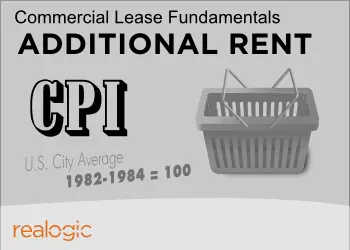
Editor’s Note: We recently updated this post on CPI in Commercial Real Estate from 2016, adding new information, expert insights, and supporting examples, as well as links to additional resources. To read the updated version of the post on CPI, click here.
Thanks to all who joined us for last week’s article about Percentage Rent. Today’s article is about the method of calculating Additional Rent referred to as CPI. Although rarely seen in new deals, CPI is still used to a lesser extent in commercial real estate leases, most often in government leases.
CPI Defined
Consumer Price Index (or CPI) is an index generated by the Bureau of Labor Statistics (BLS) that measures “the prices paid by urban consumers for a representative basket of goods and services.”
The BLS doesn’t only publish one CPI either. There are several different indices based on the following factors:
- Location (national average vs. regional index)
- Type of consumer (all urban consumers vs. wage earners and clerical workers)
- Goods and services included (all items vs. specifically defined goods and services)
- Base index period (i.e., the starting point for measurement of the index, stated as 100.0)
So, why is CPI important for Commercial Real Estate? It turns out, CPI is used by some commercial real estate leases in an attempt to fairly increase (or decrease) the rent required to be paid by a tenant to correspond with changes in national or regional inflation. To help understand CPI increases, let’s consider this example:
CPI Example
The Initial Base Rent of the lease shall be increased on each June 1st by the increase in CPI over the Base Index. The Base Index is that value published immediately prior to the lease Commencement Date.
- Commencement Date: 06/01/2014
- Initial Base Rent: $20,000 per Year
- Index in Use: “CPI-U, All Urban Consumers, U.S. City Average, 1982/84=100”
In order to accurately calculate the Rent Increase, the CPI table will need to be referenced each year through the government website. Most leases reference the index published immediately prior to a particular date. It is standard practice that there is a 2-month lag time in the publication of CPI tables so, for this example, a 6/1/14 Commencement Date would mean the index published for 4/14. I’ve included a sample CPI table with hypothetical future index values to complete the exercise.
| Index Date | Index Value |
|---|---|
| April 2014 | 194.60 |
| April 2015 | 201.50 |
| April 2016 | 206.686 |
| April 2017 | 214.823 |
The first CPI increase is scheduled to occur on 6/1/15 by comparing the Base Index value (194.6) with the value published immediately prior to the date of the scheduled increase (201.5). With these numbers, we now know that the tenant will be required to pay the landlord Rent of $20,710.00 annually. Let’s consider this formula:

And now apply it to our numbers.
(201.5 - 194.6) ÷ 194.6 = 0.0355
0.0355 x 100 = 3.55%
$20,000 x 3.55% = $710.00
The $710.00 represents the increase caused by the change in CPI so, effective 06/01/2015, the annual base rent would be $20,710 and would be up for re-calculation on 06/01/2016.
It should be noted that:
- Not all leases with CPI increases bump each lease year
- Some leases may have calendar year or mid-term increases
- Some leases may have caps or floors on the CPI increase
- The amount of CPI adjustment is unknown at lease commencement so it is often disregarded in the calculation of leasing commissions.
It’s important to remember that the majority of recently executed leases used fixed rent steps (i.e., 2% / year or $0.50/sf/year) as opposed to CPI adjustments, thereby reducing the amount of time needed to determine the rent adjustment.
That’s it for Consumer Price Index and how it gets used to adjust Base Rent in Commercial Real Estate. If you would like more information about commercial real estate in general, download the free CLF Cheat Sheet available beneath this article. Remember also to stop by next Wednesday when I’ll introduce the next topic in the Commercial Lease Fundamentals series, Lease Options.













